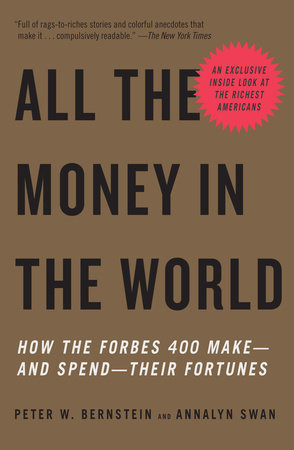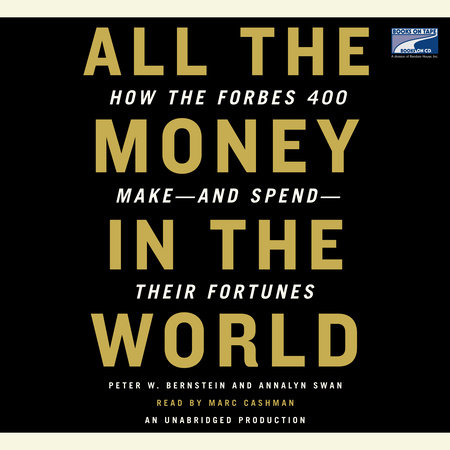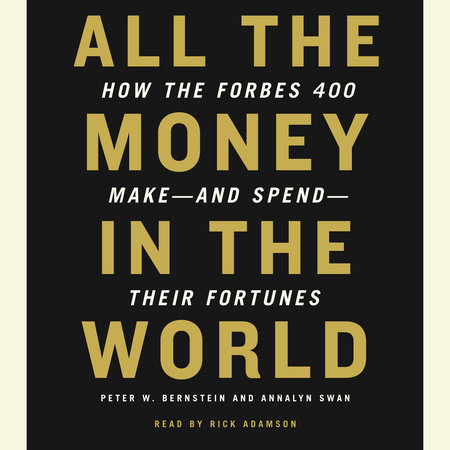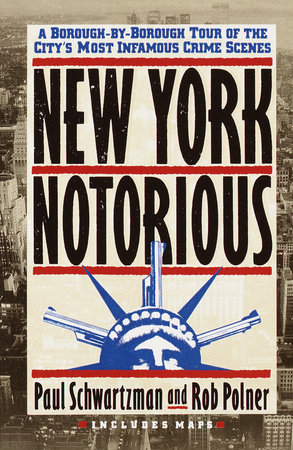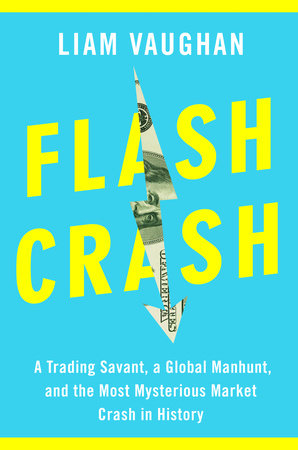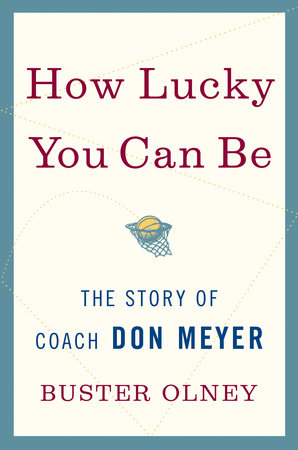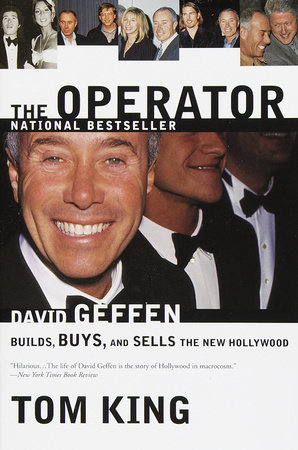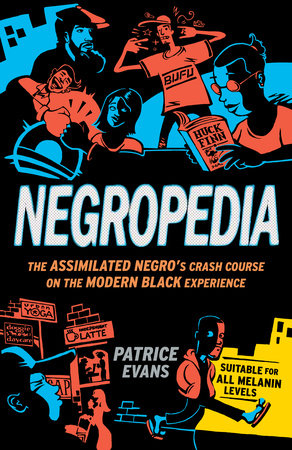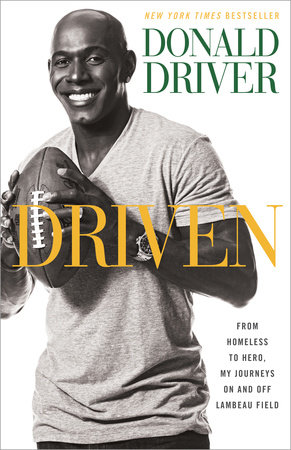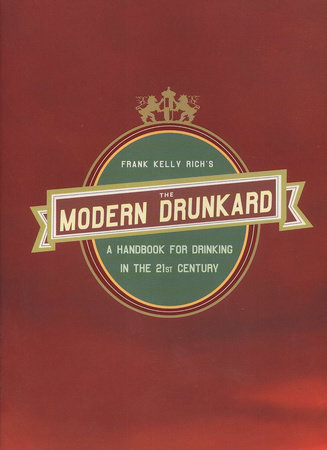Q: What do the richest people in America have to teach us about making money? Do they all have something in common?
There’s lots to learn by studying America’s super-rich. While it’s hard to generalize about any group of 1302 people–the number who have appeared on the list since it first appeared in 1982–our study led us to conclude that those that make the 400 are truly different in certain key respects. For example, they seem to have a different tolerance for risk-taking than the average entrepreneur or businessperson. (Not coincidentally, many are card-players and like to gamble.) It’s not that they necessarily take bigger risks in business, but they are better at calculating downside risk. Some 400 members, of course, have had brushes with personal bankruptcies, but statistically not all that many. (Being lucky is another key trait shared by many of the 400.) And many 400 members whom we interviewed are contrarians. When you’re selling, they’re buying.
But the single biggest common denominator we found is a tremendous amount of drive and focus to succeed. Not necessarily to make money per se, but to succeed.
Q: What’s the most important factor in making the Forbes 400 list? Inheriting loads of dough? Getting a top-notch education?
Those happen to be the two most common assumptions about the very rich–the first, that most have inherited their money, and the second, that they have parlayed a top-notch education into masses of money. The reality is far more complex. While it is true that the single easiest way to make it onto the list remains inheriting a fortune, fewer and fewer heirs are showing up in the ranks of the 400–down from 47 percent in 1982, the year the list was founded, to 30 percent in 2006. What’s more, when we looked at twelve of the “old money” families most associated with wealth in this country–the Rockefellers, DuPonts, Hearsts, etc.–we found that the percentage of Forbes 400 wealth held by the families collectively fell from 21.4 percent in 1982 to 1.7 percent in 2006. Of course, they still have plenty of money–just not the biggest fortunes of today.
As for education, it turns out that a “blue-chip” degree doesn’t translate into much beyond good connections. Overall, those who have never graduated from college–some 10 percent of the list annually–are richer than those with a degree or degrees. And of the top five on the 2006 list, four–Bill Gates, casino impresario Sheldon Adelson, Oracle’s Larry Eillson, and Microsoft cofounder Paul Allen, with a combined net worth of a staggering $110 billion–are all college dropouts.
Bottom line, personal determination and drive are far more important than either education or inherited wealth.
Q: How has the Forbes 400 list changed over the past 25 years? How does that reflect trends in the way that wealth is generated in the United States?
The makeup of the 400 has changed dramatically over the last 25 years, both in terms of who’s on the list and where their money comes from. While in 1982 almost half of the individuals on the list inherited their fortunes, today almost three-quarters of the richest Americans are self-made. Similarly, twenty-five years ago, oil and manufacturing were responsible for the largest number of fortunes–23% and 15% respectively. Today, the biggest sources of fortunes are finance (almost 25%), media (14%) and technology (12%). And there’s been a huge shift in the geographic distribution of wealth as well–from east to west. The number and percentage of Forbes 400 fortunes in California has almost doubled over the life of the list. Meanwhile, there has been a sharp decline in New York fortunes–though things could be shifting again with the growth in private equity and hedge fund fortunes.
Q: There are so many surprising facts and statistics in this book. What is the single most interesting thing you learned in the process of researching and writing this book?
That’s like asking a parent which child is his favorite! Probably the single most fascinating thing we learned is how surprisingly different and textured the composite 400 are, unlike so many of the clichés about the super-rich that appear in movies, magazines and the media in general. First off, their fortunes aren’t just derived from finance, high tech or entertainment, to name three high-profile fields. What we call blue-collar billionaires in fact account for 10 to 20 percent of the fortunes in any given year. There’s nothing new about collecting garbage, but that’s how serial billionaire Wayne Huizenga made his first fortune. J.B. Hunt started his trucking empire by finding new uses for poultry litter. And 99 cent stores, today’s equivalent of the old five and dime, are the source of another 400 fortune.
Nor does the spending of the very, very rich jibe with popular notions. Most Forbes 400 members aren’t champagne-swilling, caviar-gorging, lavish partying types–though some certainly are, and their exploits are covered in the Conspicuous Consumption chapter of our book. Certainly the 400 have the money to spend: their fortunes have soared much faster in the past 25 years than the amount needed to support a lavish lifestyle, as our Cost of Living Well chart in the book clearly shows. But it must be said that many of the best examples of excess and pretension over the last 25 years have in fact been the work of the lesser rich. And another plus on the side of the super-rich: philanthropic giving remains a powerfully entrenched tradition among America’s wealthiest people (though the evidence suggests that the super-rich are no more generous than less rich Americans in giving away their money, if you consider their giving in terms of their overall wealth.)
Q: How long did this project take you, and whom did you interview to get so much data? Were members of the Forbes list willing to talk to you?
We were extremely lucky in that, throughout the three years we worked on All the Money in the World, we, together with our team of talented writer/reporters, had great access both to the 400 themselves and to a vast database at Forbes of never-before-compiled facts and figures about America’s biggest fortunes. We collectively interviewed or corresponded with dozens of 400 members themselves and their family members, as well as with many writers, professors and analysts who have thought and written about wealth. We also compiled original statistics on everything from which colleges have the richest graduates (MIT is the winner), to who lost and gained the most money when the dot-com bubble burst in 2000/2001 (Bill Gates and Warren Buffett, respectively, to the tune of billions of dollars) to the richest immigrants (Sergey Brin, from Russia, followed by Germany’s John W. Kluge) to how many fortunes come from blue-collar businesses (at least 175 over the past 25 years). And on and on.
Q: Why do you think the list is predominantly comprised of white males?
That remains a great, unanswered mystery of the 400 list. While it stands to reason that, as the number of heirs on the list dwindled over the years versus self-made millionaires and billionaires, so the number of heiresses declined as well. But why aren’t there more self-made women to match the growing numbers of self-made men–especially during a period when more and more women entered the workforce and maintained full-time careers? Of the richest women on the 400 list over the past 25 years, only one–Doris Fisher, cofounder of the Gap–didn’t inherit her money from a family or spouse. Self-made female billionaires are so scarce that they are the genuine celebrities of the list, among them Oprah Winfrey, Estee Lauder and Martha Stewart.
The lack of female 400 members so intrigued us that we asked many of the billionaires whom we interviewed why they thought that so few women had made it to the top of the money tree. And no one was brave enough to hazard a guess!
Q: How do the richest Americans compare to the richest people worldwide?
That’s a fascinating question, and one that points to a tremendous amount of flux at the moment. For two decades, Americans have dominated the Forbes companion list of the World’s Richest People. But other nationalities are catching up fast. Americans accounted for 44 percent of the world’s richest people in 2007, but that’s down 3 percent from a year before. The list currently includes billionaires from 53 countries, which shows the growing globalization of wealth. The top 20, who accounted for an eye-popping $537 billion among them, came from 11 different countries. (The list does not include royals and dictators, or anyone who makes his or her money directly from the state.) And just as Americans make their money in increasingly varied ways, so too do the world’s billionaires. Mexican industrialist Carlos Slim Helu, the second richest man in the world after Bill Gates–some claim he has now surpassed Gates–made his fortune in banking, construction, mining, auto parts, real estate, insurance, and a seven-year monopoly over the Mexican telecom market in the 1990s. Sounds like the story of a variety of 400 members all rolled into one.
Q: I want to be on the Forbes 400 list — what should I do first? Second?
First thing I would do, of course, is read this book! For less than the price of anything on the Forbes Cost of Living Well Index–even a year’s subscription to Forbes magazine or a 10-minute long distance call (without calling plan) from NY to London–it will give you lots of ideas about how people over the past 25 years have accumulated vast wealth. Surprisingly, too, the book points out how and when to be a cheapskate–cutting costs being something at which 400 members are very good. Sometimes, as we discuss in the Winning is Everything chapter, they push the concept of spending the least possible money for the greatest possible return to the point of ruthlessness. As a group, they didn’t make their billions by being the high-cost producers of various items or services.
Our second piece of advice would be to follow a passion. Interestingly, most 400 members didn’t set out with the goal of making oodles of money. Their fortunes often resulted, as we write, from “hard work, homework and sheer drive to succeed”–not to mention more than a little good luck and fortuitous timing.
Q: Who do you think will top the 25th anniversary edition of the list?
There would be huge, huge headlines if Bill Gates weren’t at the top of the list. He has dominated the competition every year since 1994. But casino mogul Sheldon Adelson may give Gates a run for his money, as it were, sometime soon. In the two years since Adelson took his Las Vegas Sands public, he has gotten rich faster than anyone else in history–making just under $1 million an hour. And Carlos Slim Helu of Mexico (see the world billionaire question above) is currently battling Gates for the title of richest man in the world, with some giving the edge to Slim. The 400 list only includes Americans.
Q: Does a huge fortune bring corresponding amounts of happiness?
So you’d think. And most of the 400 members we asked to comment agreed, on balance, that money often does bring happiness. But not always. One of our favorite responses came from T. Boone Pickens, who said, “A happy person with money is probably happier, and an unhappy person with money is never happy. Money is not going to fix it. At least that’s what my mother used to tell me–and it’s true.” Another great response came from Google backer Kavitark Ram Shriram, who coined his own koan. “Money does not bring happiness,” he wrote. “It brings complexity.”
